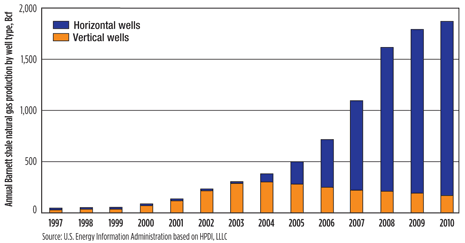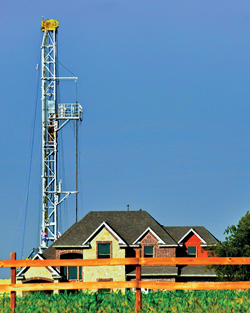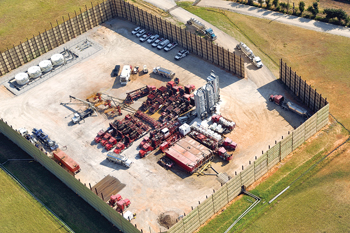JIM REDDEN, Contributing Editor
 |
| A Chesepeake Energy drilling rig makes hole near the stadium for the Dallas Cowboys professional football team in Arlington, Texas. Photo courtesy of David McNeese on behalf of Chesapeake Energy Corporation. |
|
In deference to American literary icon Mark Twain, reports of the death of the Barnett shale play have been greatly exaggerated. Even though the active rig count plummeted to a seven-year low in late 2011, impervious Barnett disciples insist that those delivering the postmortem for the granddaddy of unconventional shale gas plays are terribly premature.
Devotees of the pioneering, 5,000-sq-mi gas-dominant play in the Fort Worth basin of north-central Texas maintain that the dwindling rig count is only part of the story. Ironically, even with rigs pulling up pipe and moving elsewhere, and some operators unloading acreage, aggregate field production reached an all-time high of 5.6 Bcfgd in May 2011, according to Tudor, Pickering and Holt, surpassing the then-record 5.3 Bcfgd produced in 2008, Fig. 1. Long-time Barnett observer Gene Powell, publisher of the Powell Shale Digest, described the production figures as “phenomenal,” considering the number of rigs making hole dropped to 53 in late October. The rig count fell to its most depressed level since June 11, 2004, and represented a fraction of the 200 units drilling in early September 2008 within the mostly urban drilling theater abutting the Dallas-Fort Worth metroplex.
 |
| Fig. 1. Annual Barnett shale natural gas production by well type. |
|
The operators, who remain committed to what is widely applauded as the field lab for hydraulic fracing, say that getting more from less primarily is a function of longer laterals, multi-well pad drilling and advanced multi-stage fracing technology. “We consider the play extremely vibrant and full of growth potential and technology continues to advance,” said Chip Minty, spokesman for Devon Energy, the Barnett’s most established and prolific producer.
Like gas producers throughout the U.S., Barnett operators are, as the Wall Street Journal reported on Dec. 31, victims of their own success. With pipelines bulging, gas prices rang in 2012 at a more than two-year low of just below $3 MMbtu, while, conversely, oil prices were hovering around triple digits. Little wonder that from an exploration perspective, the Barnett has come to resemble the once-adored love interest thrown aside when a more attractive option comes along, which, in this case, are the liquids-rich Bakken and Eagle Ford shale plays. Then again, even as some operators elected to pull up stakes, there were others, including gas-hungry international concerns, that last year were more than willing to take over discarded acreage.
As if slumping gas prices were not enough to put a damper on ongoing drilling activity, the Barnett also is somewhat of an anomaly, in that it perhaps is the most tightly regulated theater in drilling-friendly Texas. In an environment where drilling sites and neighborhoods often are one and the same, operators must comply not only with the usual state and federal regulatory provisos, but also find themselves dealing with any number of city councils and homeowners associations, the latter holding tremendous clout in Texas, Fig. 2. Not surprisingly, much of the new technologies introduced over the past year have focused on slashing the environmental footprint in an attempt to ease complaints from local governing bodies and non-royalty holding residents.
 |
| Fig. 2. The proximity of rigs to urban communities heightens the urgency to develop technologies and processes to reduce the environmental footprint. Photo courtesy of Gary Grimm. |
|
However, one section of the Barnett where optimism is high is the oil window in the so-called Combo play of the northern portion of the Fort Worth basin, primarily underlying Montague and Cooke Counties. The gas and natural gas liquids (NGL) structure has emerged as a key target for EOG Resources, which recently completed a major 3D survey of its holdings in Montague County, where it holds a predominant position, along with Pioneer Natural Resources. The Texas Railroad Commission (TRRC) approved 471 drilling permits for Montague County during 2011, with EOG and Pioneer leading the pack with 351 and 49 drilling authorizations, respectively.
RICH IN GAS, HISTORY
With its core traversing most of Wise, western Denton and northwestern Tarrant Counties along the Bend Arch-Fort Worth basin, the original Newark East field remains the heart of the 23-county Barnett shale play. According to the TRRC, by the end of September 2011, a cumulative 15,306 wells had been drilled in the gas-bearing Mississippian shale, with an additional 3,212 permitted locations. By 2006, the Newark East had emerged as the largest producing gas field in Texas, and one of the largest in the nation in terms of cumulative production.
Mitchell Energy Corp. drilled the Newark East discovery well in 1981 in Wise County, but development remained lackluster until the late 1990s, when the tenacity of the operator’s founder, George Mitchell, resulted in the full-scale emergence of hydraulic fracturing, which is credited with unleashing the worldwide boom in shale exploration and production. Devon Energy acquired Mitchell Energy in 2002 and remains the largest and most established Barnett producer.
The thickness of the shale in the core production area ranges from 50 ft in the south to more than 1,000 ft in the northwest portion. In contrast, the thickness of the liquids-rich, 90,000-acre core area of the Combo play of eastern Montague and western Cooke counties varies between 1,400 and 1,700 ft. There, the middle Ordovician Viola limestone formation forms a seal beneath the Barnett shale, facilitating hydraulic fracing.
Mark Papa, EOG chairman and CEO, went so far as to tell shareholders last year that the Barnett Combo is “one of the richest oil deposits we’ve ever encountered.” He estimated the play holds in-place reserves of 70 MMbbl of oil and 175 Bcf of gas per section. One section comprises 640 acres.
BILLION DOLLAR ASSET SWAPS
Paradoxically, even as some ostensibly entrenched operators and contractors appear to have lost faith in the future of the Barnett, others from as far away as Australia take an entirely different view. Over the past year, they put their cash where their view is, to the tune of deals reportedly worth well over $900 million each. Nevertheless, even with the new players, rigs actively making hole in the core gas play are forecast to be few and far between, as there appears to be no imminent relief to sagging commodity prices. On the other hand, if EOG and Pioneer drilling plans are any indication, exploration activity in the Barnett Combo liquids play is expected to remain comparatively brisk during the year.
In late October, home-grown drilling contractor Union Drilling Co. led the exodus, announcing it would relocate most of its fleet from the Barnett to the Permian basin. The Fort Worth-based contractor said the strategy shift would have 16 rigs drilling the Permian and only four in the Barnett. Dan Morrison, managing director and senior energy analyst with Fort Worth-based Global Hunter Securities, said the emigration of gas drillers is expected to continue, telling the Fort Worth Star Telegram late last year that with the continued weak gas prices generally forecast for this year, “it’s going to be hard for them to keep the rigs running.”
On the other hand, there are those betting considerable dollars that prospects will improve in the not-so-distant future. Partnerships managed by privately-held EnerVest Ltd. of Houston, which acquires and operates oil and gas properties for institutional investors, was the biggest spender, shelling out a reported $975 million in August to acquire the Barnett properties of Encana Oil & Gas (USA) Inc. The acquisition entails 52,000 net acres and estimated production of 125 MMcfgd, as well as the associated pipeline gathering network. The Encana acquisition follows on the heels of EnerVest’s earlier $967-million purchase of a 31% interest in the Barnett holdings of Dallas independent Talon Oil & Gas LLC. With the agreement, EnerVest procured interest in 20,207 gross acres that include 3D seismic data and 212 active wells producing 87 MMcfd of gas equivalent and 1.1 Tcfe of estimated reserves.
Meanwhile, in May 2011, Fort Worth’s own Range Resources Corp. said it was giving up on the hometown play and selling 52,000 net acres and 390 producing wells to Barnett newcomer Legend Natural Gas IV, LP, of Katy, Texas, for $900 million. Range, however, said that, for the time being, it was holding on to certain non-producing Barnett acreage.
While some domestic operators choose to explore elsewhere, international producers also turned their sights on the Barnett as part of their strategy to get a foothold in the burgeoning U.S. shale plays. In December, Australia’s Petrel Energy Pty Ltd. and Orion Petroleum Ltd. released details of a joint venture (JV) that covers 6,000 acres operated by JV partner The Cummings Co. The first phase of the JV’s Barnett campaign included the drilling of one saltwater disposal well and three gas development wells. This formation of a JV was the second involving an international partner. In early 2010, Barnett stalwart Chesapeake Energy formed a $2.25-billion JV with France’s Total, which agreed to foot the bill for 60% of the drilling and well completion costs. A $471-million cash payment to Chesapeake last November covered the remaining drilling costs, providing an earlier-than-expected ending to Total’s obligation in the JV. In related developments, operators XTO Energy and Quicksilver Resources reportedly met with visiting Chinese and Japanese producers, respectively, last year though no definitive agreements were announced. However, China’s CNOOC and Sinopec were widely reported to be in competition to snag a 30% stake in Fort Worth fracing specialist FTS International, formerly known as Frac Tech.
SEEKING HIGHER OUTPUT
The latest figures available from the TRRC show that for the first six months of 2011, the venerable Barnett produced a total of 1.092 Tcf of gas, averaging around 5.15 Bcfd and accounting for 31% of Texas gas production. Nevertheless, even as the Barnett reached the lofty milestone of 8 Tcf of cumulative production last year, the U.S. Energy Information Agency (EIA) noted that this was insufficient to prevent it from taking a backseat to the Haynesville shale play that spreads across East Texas and much of western Louisiana, and which, by March 2011, emerged as the nation’s premier gas producer. Haynesville operators give most of the thanks to their neighbor to the west. Much of the credit for the emergence of the newer Haynesville is being attributed to earlier experiences with Barnett horizontal wells.
“The Barnett tends to experience high initial production rates before beginning steep declines 12 to 18 months after wells are put on line. After that, production tends to pretty much level off,” said Dr. Ed Ireland, executive director of the Barnett Shale Energy Education Council. In addition, the U.S. Department of Energy’s National Energy Technical Laboratory (NETL) suggests that current gas recovery throughout the Barnett is only 10% to 15% of the reserves in place. The reason being, NETL contends, is that this extremely tight formation is limited by diffusive gas transport from the matrix storage to the stimulated fracture network. In an attempt to increase recovery rates, the University of Texas at Arlington is spearheading a systematic NETL study under the moniker “Integrated Experimental and Modeling Approaches to Studying the Fracture-Matrix Interaction in Gas Recovery from Barnett Shale.” The outcome of this ongoing investigation, according to NETL, is aimed at “bridging the knowledge gaps in the pore connectivity effect on diffusive gas transport and gas recovery in a fractured shale system, which leads to improved gas recovery and associated economic benefits.”
In another effort to increase long-term production, Halliburton last year introduced its AccessFrac technology, which the company says combines specially engineered diversion technologies and pumping capabilities to create a process that helps shale operators achieve better long-term production, Fig. 3. The service involves a process aimed at ensuring each perforation cluster in an interval receives the designed amount of proppant to ensure full stimulation. As of Oct. 31, 2011, Halliburton claimed the process had been used more than 50 times in a variety of Barnett frac operations.
 |
| Fig. 3. A Halliburton fracing configuration at a Barnett Shale location. The service company’s AccessFrac technology has been employed in more than 50 Barnett applications. |
|
Meanwhile, operators specifically credit longer horizontal sections, improved completion technology and the drilling of multiple wells from a single pad for not only increasing output, but doing so economically and with reduced environmental impact. Devon, for instance, says some laterals that were once 2,000 to 4,000 ft long now exceed 5,000 ft in length.
Devon and other operators are drilling more wells from a single location, with the Oklahoma operator citing one pad in southwest Tarrant County accommodating more than 30 wells. ExxonMobil subsidiary XTO Energy said it has produced more than 14.8 Bcf of gas from a drilling pad near Eagle Lake in northwest Tarrant County that is expected to include as many as 35 wells by March. Devon spokesman Minty said the drilling of several wells from a single location also has allowed the Barnett operators to be more profitable, despite less-than-attractive gas prices. “It (pad drilling) is much more economical, efficient and also is environmentally beneficial, as we reduce the surface disturbance.”
2012 DRILLING OUTLOOK MIXED
While operators in the oil and condensate Combo play plan comparatively robust drilling programs this year, new exploration prospects in the south could fall victim to depressed gas prices. Some drilling plans announced early on could look entirely different as the year progresses.
Devon Energy recorded Barnett production of 1.3 Bcfd of natural gas equivalent in third-quarter 2011, representing an 8% increase over the same period in 2010. During 2011, Devon’s drilling program called for 320 gross wells, a decline from 460 drilled in the previous year. The top producer in the Barnett intends to keep 12 rigs drilling during 2012 to develop its dominant Barnett lease position of well over 630,000 net acres. This year, Devon expects to drill its 5,000th well in the play.
EOG Resources focuses on the liquids-rich Barnett Combo play of Montague and Cooke Counties, where it holds a dominant position and is one of the very few operators to announce an appreciable increase in 2012 drilling. The operator says it will ramp up its drilling program in the Barnett Combo, going from nine to 14 rigs to exploit the 175,000 net acres it holds in the north Fort Worth basin. The current drilling campaign also takes into account the 2010 re-evaluation of its exploration strategy for the easternmost portion of the Combo play, where the thicker shales were exploited with vertical wells. The results of its early horizontal drilling campaign prompted EOG in 2010 to change from a 50-50 split to a drilling program that called for 200 horizontal and 34 lateral wells. The operator has identified more than 950 drilling locations and says that by 2012, half of its Barnett production will come from its Combo holdings.
Chesapeake Energy, the second largest Barnett gas producer, was operating 15 rigs at the end of 2011 to explore the 220,000 net acres it has leased in the core gas area. The Oklahoma City operator recently established a gross production record of 1.3 Bcfed. While the deal with Total calls for a minimum of 12 rigs in the Barnett, Chesapeake has warned that the drilling program could change, if gas prices do not recover this year.
Pioneer Natural Resources plans to use two rigs to drill 48 wells, primarily in the Barnett Combo area this year, versus 43 drilled last year. The Fort Worth independent has 80,000 gross acres under lease in Montague and Wise counties, holding approximately 120 Bcfe of proved reserves and more than 600 Bcfe of additional net resource potential. The operator has identified more than 900 drilling locations in the Barnett Shale. The operator earlier acquired 70 sq mi of 3D seismic over its Combo holdings.
XTO Energy. The ExxonMobil division closed 2011 with seven rigs operating within the estimated 280,000 net acres it holds, primarily in the core gas area. The operator has some 2,000 producing wells in the Barnett and plans to maintain production at around 850 to 900 MMcfd.
Carrizo Oil & Gas began 2012 with no rigs operating in the 32,000 net acres it has leased in the Barnett. While no new wells are planned to be drilled this year, the operator intends to put an estimated nine wells drilled earlier into the production stream in first-quarter 2012. Carrizo’s Barnett properties contain proved reserves of 534 Bcfe with an additional 489 Bcfe net potential. Net production is more than 105 MMcfed.
Quicksilver Resources took over 100% ownership of the Lake Arlington lease in mid-2010, when it purchased the remaining 25% of Fort Worth’s Marshall R. Young Oil Co. The acquisition boosted Quicksilver’s Barnett holdings to approximately 155,000 net acres, which it says contains proved reserves of 2.6 Tcf of gas equivalent. The operator, which runs two rigs in the area, increased production from 217.3 MMcfgd in 2010 to 277.6 MMcfgd last year. In late 2011, Quicksilver also had 39 net operated wells awaiting completion and connection to sales lines.
WPX Energy, which was formally created this year in a spin-off from the Williams Companies, increased production from 59 MMcfed in 2010 to 67 MMcfed by third-quarter 2011. The newcomer, which became a publicly traded entity on Jan. 3, has 134,015 net acres under lease in the Barnett with 0.2 Tcfe of proved reserves. The operator has one rig operating in the Barnett, where it has interest in 300 wells.
ConocoPhillips sold its holdings in the south Barnett area to investment firm Kohleberg Kravis Roberts & Co. as it shifted focus to its 144,000 net acres in the liquids play of north-central Texas. The major says it averaged net production of 6,000 bpd of liquids and 62 MMcfd of gas in the northern portion of the Fort Worth basin, where it had expected to add 30 new wells last year.
RESTRICTIONS INSPIRE TECHNOLOGIES
Compounding the low gas prices are federal, state and local restrictions that cover everything from air quality to the make-up of frac chemicals. Pre-empting potential federal legislation, the TRRC intends to finalize regulations this year that would require operators to disclose certain chemicals used in fracing operations. The TRRC move is in line with the Independent Petroleum Association of America (IPAA), which is leading the industry charge for more open disclosure.
Barnett operators, however, not only must comply with the state and federal restrictions, but also find themselves coping with local city councils, which are reviewing, and in many cases, tightening drilling ordinances. With Texas contending with the record drought of 2011, it is not surprising that city governments would look harshly at the enormous volumes of water required for hydraulic fracing operations. In the heat of the summer, the Southlake City Council in Tarrant County enacted one of the region’s most restrictive policies, prohibiting any wells within its jurisdiction from being fraced between June and August. The decision prompted Chesapeake to announce in early November that it would allow the last of nearly 1,400 leases in the Southlake area to expire. Local opposition, likewise, forced XTO to scrap plans for two pad sites in Southlake and Keller.
Well before the drought of 2011, Devon had made its mark as the first natural gas producer in the Barnett Shale to embrace large-scale water recycling. Today, the operator works exclusively with Fountain Quail Water Management of Jacksboro, which has recycled more than 700 million gal of Devon’s flowback and produced water in the Barnett. In Oct. 2011, the water management company introduced its mobile ROVER system to the Barnett, which is a portable self-contained unit capable of treating 10,000 bpd of flowback and produced water.
Owing to the urban drilling environment of the Barnett, the Houston Advanced Research Center (HARC) is looking at everything from air emissions to surface disturbance as part of its Environmentally Friendly Drilling Program (EFDP). The center has particular interest in the Barnett considering its founder is the legendary Mitchell, whose son Todd currently serves as HARC chairman. In addition to studying air emissions to identify accurate and cost-effective sensors, HARC also works closely with Texas A&M University, as a partner in the EFDP initiative, which is looking at ways of reducing the impact of rig roads, as well as the re-use of drill cuttings.
NEW YEAR BRINGS HOPE
Not everyone is wholly pessimistic when it comes to the prospects that gas prices could see a recovery this year and spur increased activity in the core Fort Worth Basin. While not particularly bullish, lease acquisition specialist Mark Caffey, CEO of the Fort Worth-based Caffey Group, told the Fort Worth Star Telegram on Dec. 30 that he believes gas prices could rise as much as 10% to 20% this year and increase even more in 2013. He cited the Legend and EnerVest acquisitions as proof positive that some are firmly confident that the Barnett is poised for resurgence. Consequently, like the prematurely reported death of a distinguished man of letters, Caffey believes folks should not be too hasty in writing the obituary for the Barnett shale. “Those were $900-million (plus) deals,” Caffey told the newspaper. “Rest assured, they (Legend and EnerVest) both expect natural gas prices to increase, or they wouldn’t have made those two expensive acquisitions.” 
|






